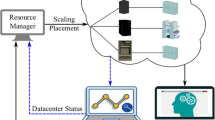Abstract
Predicting cloud performance from user’s perspective is a complex task, because of several factors involved in providing the service to the consumer. In this work, the response time of 10 real-world services is analyzed. We have observed long memory in terms of the measured response time of the CPU-intensive services and statistically verified this observation using estimators of the Hurst exponent. Then, naïve, mean, autoregressive integrated moving average (ARIMA) and autoregressive fractionally integrated moving average (ARFIMA) methods are used to forecast the future values of quality of service (QoS) at runtime. Results of the cross-validation over the 10 datasets show that the long-memory ARFIMA model provides the mean of 37.5 % and the maximum of 57.8 % reduction in the forecast error when compared to the short-memory ARIMA model according to the standard error measure of mean absolute percentage error. Our work implies that consideration of the long-range dependence in QoS data can help to improve the selection of services according to their possible future QoS values.








Similar content being viewed by others
References
Amin A, Colman A, Grunske L (2012) An approach to forecasting QoS attributes of web services based on ARIMA and GARCH models. In: Proceedings of 19th IEEE international conference on web services (ICWS 2012), pp 74–81. doi:10.1109/ICWS.2012.37
Beran J (1994) Statistics for long-memory processes, vol 61. CRC Press, New York
Brockwell PJ, Davis RA (2002) Introduction to time series and forecasting. Taylor & Francis, USA
Cavallo B, Di Penta M, Canfora G (2010) An empirical comparison of methods to support QoS-aware service selection. In: Proceedings of the 2nd international workshop on principles of engineering service-oriented systems, ACM, pp 64–70. doi:10.1145/1808885.1808899
Elbiaze H, Zhani MF, Cherkaoui O, Kamoun F (2010) A new structure-preserving method of sampling for predicting self-similar traffic. Telecommun Syst 43(3–4):265–277. doi:10.1007/s11235-009-9201-x
Fraley C, Leisch F, Maechler M, Reisen V, Lemonte A (2012) fracdiff: Fractionally differenced ARIMA aka ARFIMA(p, d, q) models. URL http://CRAN.R-project.org/package=fracdiff
Ghaderi M (2003) On the relevance of self-similarity in network traffic prediction. School of Computer Science, University of Waterloo, Technical report
Granger CW, Joyeux R (1980) An introduction to long-memory time series models and fractional differencing. J Time Ser Anal 1(1):15–29. doi:10.1111/j.1467-9892.1980.tb00297.x
Hurst HE (1951) Long-term storage capacity of reservoirs. Trans Am Soc Civ Eng 116:770–808
Hyndman RJ, Athanasopoulos G (2014) Forecasting: principles and practice. OTexts. URL https://www.otexts.org/fpp/
Hyndman RJ, Athanasopoulos G, Razbash S, Schmidt D, Zhou Z, Khan Y, Bergmeir C (2014) forecast: Forecasting functions for time series and linear models. URL http://CRAN.R-project.org/package=forecast
Leitner P, Ferner J, Hummer W, Dustdar S (2013) Data-driven and automated prediction of service level agreement violations in service compositions. Distrib Parallel Databases 31:447–470. doi:10.1007/s10619-013-7125-7
Leland WE, Taqqu MS, Willinger W, Wilson DV (1993) On the self-similar nature of Ethernet traffic. SIGCOMM Comput Commun Rev 23(4):183–193. doi:10.1145/167954.166255
Leland WE, Taqqu MS, Willinger W, Wilson DV (1994) On the self-similar nature of Ethernet traffic (extended version). IEEE ACM Trans Netw 2(1):1–15. doi:10.1109/90.282603
Malamud BD, Turcotte DL (1999) Self-affine time series: I. Generation and analyses. Adv Geophys 40:1–90. doi:10.1016/S0065-2687(08)60293-9
Mandelbrot BB (1967) How long is the coast of Britain. Science 156(3775):636–638. doi:10.1126/science.156.3775.636
Mandelbrot BB (1983) The fractal geometry of nature. Macmillan, New York
Mandelbrot BB (1997) Fractals and scaling in finance: discontinuity and concentration. Springer, New York
Mandelbrot BB, Wallis JR (1968) Noah, Joseph, and operational hydrology. Water Resour Res 4(5):909–918. doi:10.1029/WR004i005p00909
Mandelbrot BB, Wallis JR (1969) Computer experiments with fractional Gaussian noises: part 3. Mathematical appendix. Water Resour Res 5(1):260–267. doi:10.1029/WR005i001p00260
Palma W (2007) Long-memory time series: theory and methods, vol 662. Wiley, New Jersey
Park K, Willinger W (2000) Self-similar network traffic and performance evaluation. John Wiley & Sons, Inc., New York
Paxson V, Floyd S (1995) Wide area traffic: the failure of Poisson modeling. IEEE ACM Trans Netw 3(3):226–244. doi:10.1109/90.392383
R Core Team (2014) R: a language and environment for statistical computing. URL http://www.R-project.org/
Schroeder M (2009) Number theory in science and communication: with applications in cryptography, physics, digital information, computing, and self-similarity, vol 7. Springer, Berlin
Serinaldi F (2010) Use and misuse of some Hurst parameter estimators applied to stationary and non-stationary financial time series. Physica A 389(14):2770–2781. doi:10.1016/j.physa.2010.02.044
Shu Y, Jin Z, Wang J, Yang OW (2000) Prediction-based admission control using FARIMA models. In: Proceedings of 2000 IEEE international conference on communications (ICC 2000), vol 3, pp 1325–1329. doi:10.1109/ICC.2000.853713
Solomon A, Litoiu M (2011) Business process performance prediction on a tracked simulation model. In: Proceedings of the 3rd international workshop on principles of engineering service-oriented systems, ACM, pp 50–56. doi:10.1145/1985394.1985402
Stone M (1974) Cross-validatory choice and assessment of statistical predictions. J R Stat Soc Ser B Stat Methodol 36:111–147
Taqqu MS, Teverovsky V, Willinger W (1995) Estimators for long-range dependence: an empirical study. Fractals 3(04):785–798. doi:10.1142/S0218348X95000692
Wickham H (2011) The split-apply-combine strategy for data analysis. J Stat Softw 40(1):1–29. URL http://www.jstatsoft.org/v40/i01/
Willinger W, Taqqu MS, Sherman R, Wilson DV (1997) Self-similarity through high-variability: statistical analysis of Ethernet LAN traffic at the source level. IEEE ACM Trans Netw 5(1):71–86. doi:10.1109/90.554723
Wuertz D (2013) fArma: ARMA time series modelling. URL http://CRAN.R-project.org/package=fArma
Author information
Authors and Affiliations
Corresponding author
Rights and permissions
About this article
Cite this article
Nourikhah, H., Akbari, M.K. & Kalantari, M. Modeling and predicting measured response time of cloud-based web services using long-memory time series. J Supercomput 71, 673–696 (2015). https://doi.org/10.1007/s11227-014-1317-4
Published:
Issue Date:
DOI: https://doi.org/10.1007/s11227-014-1317-4




